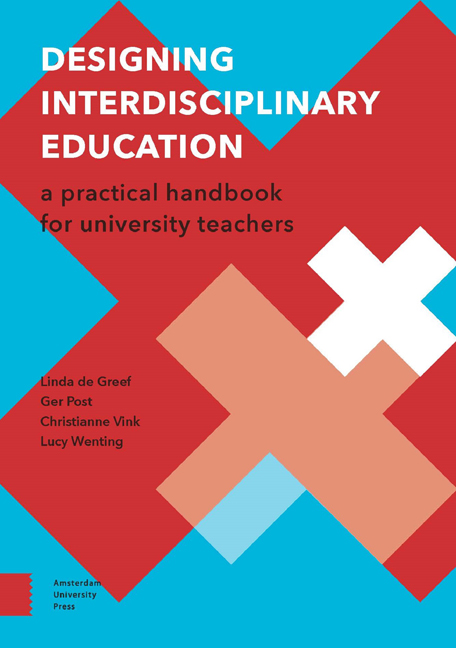Book contents
- Frontmatter
- Contents
- Acknowledgements
- 1 Introduction
- 2 An Overview of the Development Stages
- 3 Unravelling Interdisciplinary Understanding
- 4 Developing the Raw Sketch
- 5 Formulating Interdisciplinary Learning Outcomes
- 6 Embedding Integration in the Programme Design
- 7 Hiring and Engaging Faculty
- 8 Exploring the Teaching Philosophy and Didactic Methods
- 9 Assessment of Interdisciplinary Learning Outcomes
- 10 Interdisciplinary Teaching in Practice
- 11 Programme Assessment and Adjustment
- Appendices
- References
- Colophon
6 - Embedding Integration in the Programme Design
- Frontmatter
- Contents
- Acknowledgements
- 1 Introduction
- 2 An Overview of the Development Stages
- 3 Unravelling Interdisciplinary Understanding
- 4 Developing the Raw Sketch
- 5 Formulating Interdisciplinary Learning Outcomes
- 6 Embedding Integration in the Programme Design
- 7 Hiring and Engaging Faculty
- 8 Exploring the Teaching Philosophy and Didactic Methods
- 9 Assessment of Interdisciplinary Learning Outcomes
- 10 Interdisciplinary Teaching in Practice
- 11 Programme Assessment and Adjustment
- Appendices
- References
- Colophon
Summary
‘A person who is a mile wide and an inch deep is not an educated person. But a person who is a mile deep and an inch wide is not an educated person either.’
Mike Edmiston
There are several ways to obtain coherence and alignment within an interdisciplinary programme, and there are multiple ways to deal with depth and breadth of knowledge. How should one cope with the wide variety of options for interdisciplinary curriculum formats? The multiplicity of choices can be somewhat overwhelming. The purpose of this chapter is to discuss how to find the best fit between the scope and learning outcomes of the programme and the format of the curriculum. Designing a programme will come down to tweaking all the constitutive elements until a balance is reached that corresponds to the programme's learning outcomes.
Four curriculum models
In our view, an ideal interdisciplinary curriculum works from the premise that students have a wide range of courses and other curriculum experiences, both disciplinary and interdisciplinary. The aim of discipline-centred courses, whether introductory or advanced, is to equip students with a solid understanding of the discipline's methods and concepts, and to apply the discipline's way of thinking to questions central to the programme. But simply educating students in the various disciplines is not enough for students to learn how to synthesise the different disciplinary insights. Students need to be trained repeatedly in interdisciplinary understanding. In interdisciplinary courses there is room to introduce additional perspectives from other disciplines on a topic, and students are guided through the interdisciplinary process that is agreed upon by the faculty. A key issue when setting up an interdisciplinary programme is the sequence of interdisciplinary courses and the emphasis on disciplinarity versus interdisciplinarity during the course of the study programme. For example, courses that focus on the integration or synthesis of disciplinary knowledge could be presented in the early phases of the programme, or students could first develop a firm rooting in a single discipline or multiple disciplines. We have experimented with a variety of approaches to interdisciplinary curriculum formats. In this chapter, we explain four models, all based on a three-year Bachelor's programme.
- Type
- Chapter
- Information
- Designing Interdisciplinary EducationA Practical Handbook for University Teachers, pp. 76 - 91Publisher: Amsterdam University PressPrint publication year: 2017

